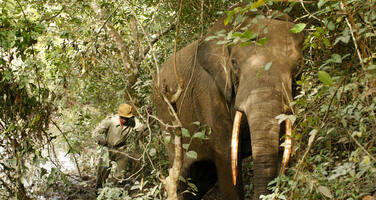Garamba National Park
Factors affecting the property in 1984*
- Illegal activities
International Assistance: requests for the property until 1984
Total amount approved : 59,120 USD
| 1983 | Equipment for rescue programme for white rhino and ... (Approved) | 40,000 USD |
| 1980 | Equipment for Garamba National Park (Approved) | 19,120 USD |
Missions to the property until 1984**
Conservation issues presented to the World Heritage Committee in 1984
By letter of 21 February 1984, the State Commissioner for Environment, Nature Conservation and Tourism of Zaire requested the Director-General of Unesco to consider the possibility of placing Garamba National Park on the List of World Heritage in Danger due to the critical situation of its white rhinoceros population.
The Bureau, at its 8th session, recalled that the Committee had granted $40,000 for emergency assistance for this property in 1983. The Bureau took note of IUCN's technical evaluation in which it was indicated that although Garamba National Park still fulfilled criterion (ii) under the Convention, it would no longer fulfil criterion (iv) (constituting habitats of endangered species) in the event that the rhinoceros population were completely exterminated.
Taking account of the IUCN recommendation and noting that all the conditions set out in the Operational Guidelines (paragraph 46) had been met, the Bureau recommended that the Committee inscribe this property on the List of World Heritage in Danger.
The technical evaluation of IUCN, with up to date information on the status of this site, is presented in the IUCN document (See Document SC.84/CONF.001/4, at https://whc.unesco.org/archive/1984/sc-84-conf001-4e.pdf ).
Analysis and Conclusion by World Heritage Centre and the Advisory Bodies in 1984
The Committee took note of IUCN's evaluation of this nomination and of up-to-date information on the very critical situation of the white rhinoceros population, now estimated to total less than 15 specimens, which means this sub-species is severely threatened. The Committee noted IUCN's observations and the positive response of the Zaire authorities to the Director General's letter and decided to inscribe Garamba National Park on the List of World Heritage in Danger.
Summary of the interventions
Decisions adopted by the Committee in 1984
8 COM X.26-27
Inscriptions on the List of World Heritage in Danger
26. The Committee examined four nominations to the List of World Heritage in Danger submitted by the States Parties concerned. The Committee noted the recommendations of ICOMOS and IUCN and made the following decisions:
Wieliczka Salt Mine (Poland)
ICOMOS provided the Committee with the information which the Polish authorities had given for this property. The Committee considered that there was insufficient geological information at present to evaluate the dangers facing this property. The Committee therefore decided to defer a decision on this nomination until more information had been obtained and expressed the wish that in the meantime the national authorities concerned ensure the necessary protection.
Djoudj National Bird Sanctuary (Senegal)
The Committee was informed by IUCN that the immediate threat posed by the earthen dam upstream from this property had been removed since the recent rains had been sufficiently abundant to wash this temporary dam away. However, the longer term threat posed by the dam to be constructed down-stream still remained and still,seriously jeopardised the future of this site. Taking IUCN's comments and reconrmendations into account, and the response of the Senegalese authorities to the Director General's request, the Committee decided to inscribe Djoudj National Bird Sanctuary on the List of World Heritage in Danger.
Ngorongoro Conservation Area (Tanzania)
The IUCN representative presented the evaluation of the conservation status of this property which had regrettably continued to decline and noted that the Tanzanian authorities had recently responded positively to the request of the Director General to inscribe this property on the List of World Heritage in Danger. Taking account of IUCN's observations, the Commi'ttee decided to inscribe Ngorongoro Conservation Area on the List of World Heritage in Danger.
Garamba National Park (Zaire)
The Committee took note of IUCN's evaluation of this nomination and of up-to-date information on the very critical situation of the white rhinoceros population, now estimated to total less than 15 specimens, which means this sub-species is severely threatened. The Committee noted IUCN's observations and the positive response of the Zaire authorities to the Director General's letter and decided to inscribe Garamba National Park on the List of World Heritage in Danger.
27. Mr. Batisse, on noting the Committee's decision to inscribe the 3 natural sites described above on the List of World Heritage in Danger, remarked that these inscriptions would constitute a test of the effectiveness of the Convention on mobilising public opinion and solidarity to provide the important national or international support necessary for their preservation.
No draft decision proposed

Exports
* :
The threats indicated are listed in alphabetical order; their order does not constitute a classification according to the importance of their impact on the property.
Furthermore, they are presented irrespective of the type of threat faced by the property, i.e. with specific and proven imminent danger (“ascertained danger”) or with threats which could have deleterious effects on the property’s Outstanding Universal Value (“potential danger”).
** : All mission reports are not always available electronically.

